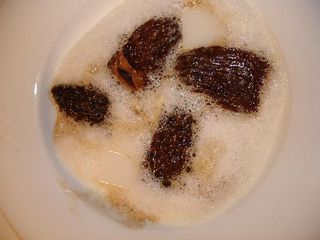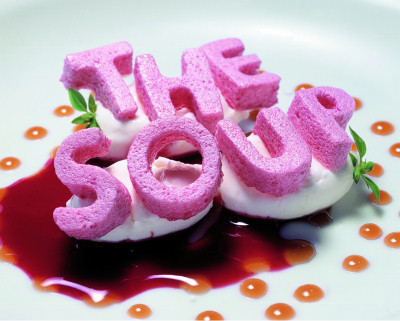From El Bulli to Apicius
I found myself decidedly unmoved by this weekend's obituaries of El Bulli ('the best restaurant in the world'). A friend of mine did make the gastronomic pilgrimage a decade or so ago, and came back full of stories of its brilliance. He had been especially impressed with the way the waiters had held appropriately scented flowers under their noses as the ate particular dishes. My reaction was not 'what brilliant attention to synaesthesia', but 'how bloody pretentious can you get?'.
Try some of his specialities (like the 'soup' above): liquid pea ravioli (that's ravioli shells, filled with pea soup) or flower paper (that's flowers pressed into a sheet of candy floss) or the ball of frozen gorgonzola. All this brings out the culinary philistine in me, or the 'Arts and Crafts, Truth to Materials' approach to cooking. (If God had wanted flowers pressed into a sheet of candy floss . . . etc etc. Or why bother to freeze good gorgonzola?)
The husband is with me on this one, but for slightly different reasons. He hates the control exercised by these celebrity cooks; the 'eat what I deign to give you' philosophy. He can't even abide the amuse-bouches so beloved of more ordinary pricy restaurants. You know where the waiter comes up with a little pot of something you hadnt ordered between courses, and explains its ingredients to you in a carefully practised French accent. His line is: "If I'd wanted a 'mousse of dew-picked mushrooms with ginger and cointreau', I'd have asked for it."

At first sight, all this is much like posh ancient Roman cookery, where again things are not always what they seem. Think, for example, of the dinner party of Petronius' Trimalchio, where half of what the diners eat is not what it seems (quinces masquerading as sea urchins for example). Or think of one of Apicius' signature recipes, 'Casserole of Anchovy without Anchovy' ('at table noone will recognise what they are eating'). (The recipe is number 139 here, but it's clear that you have to read sine ('without') not sive ('or') -- sive is a desperate attempt not to see the point.)
But it isn't quite so simple. For while Trimalchio is showing off in an El Bulli type way, Apicius is trying to save money (sea nettles and eggs being, I imagine, cheaper in the Roman market place than bona fide anchovies). Which reminds us of the iron law of cookery, that (William Morris or no William Morris) the whole discipline from top to bottom is riddled with (or rests upon) attempts to turn things into something they are not: chicory into coffee, quorn into bacon, nuts into cutlets, flour into bread. It's not just the rich turning soup into ravioli parcels, the poor try to make you think sea nettles are anchovy -- and all of us prefer a crusty loaf to raw flour, water and yeast. What the El Bulli's of this world are doing is only a development of the essentials of cookery (turning 'the raw into the cooked').So shouldn't I stop the moralising?
And indeed when you actually experience (ie eat) one of those really clever confections, it is actually rather exciting. It is easy enough to huff and puff in theory, but when I had a lemon mousse in Washington that looked for all the world like a soft boiled egg, I was truly enchanted.
'Truth to materials', I guess, doesn't have quite the role in cookery as it does in architecture.
(It's El Bulli's 'morels in cream foam' above, by the way; wonder what the 'foam' is.)
Mary Beard's Blog
- Mary Beard's profile
- 4112 followers




